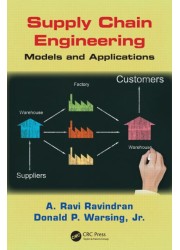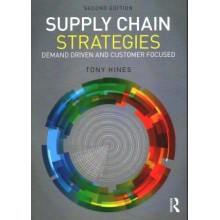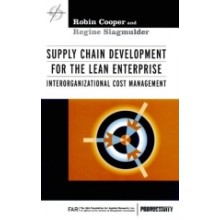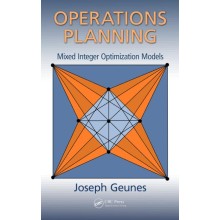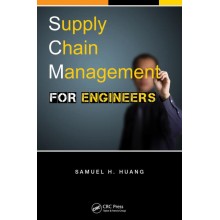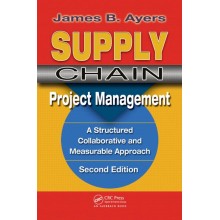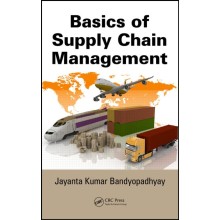Supply Chain Engineering: Models and Applications
ISBN: 9781439811986
Author: A. Ravi Ravindran, Donald P. Warsing
Dispatch Time: 15 - 30 Days
Quantity:
-
Add to Compare
Emphasizing a quantitative approach, Supply Chain Engineering: Models and Applications provides state-of-the-art mathematical models, concepts, and solution methods important in the design, control, operation, and management of global supply chains. The text provides an understanding of how companies plan, source, make, and deliver their products to create and/or maintain a global competitive advantage. It emphasizes application of operations research models and methods to optimize the various components of an integrated supply chain.
The authors have carefully constructed the book so that it is not so "micro" in its focus that the perspective on the larger business problem is lost, nor is it so "macro" in its treatment of that business context that it fails to develop students’ appreciation for, and skills to solve, the tactical problems that must be addressed in effectively managing flows of goods in supply chains. Building students’ knowledge of the first principles of supply chain engineering, the book covers the traditional issues in operations, logistics, and supply chain management—forecasting demand, managing inventories, managing transportation, and locating facilities. It also includes a number of new optimization tools such as risk pooling, for addressing these problems, based on recent research.
In addition, the authors’ treatment of managing customer-supplier relations supplies a fresh perspective that draws on recent research using multiple criteria optimization methods. Moreover, the chapter on managing risks in supply chains presents important problems that extend beyond the traditional treatment of supply chain management. Building a bridge between theory and practice, the authors pull all of these themes together in the culminating chapter that solidifies students’ understanding of managing global supply chains.
Table of Contents
Introduction to Supply Chain Engineering
Understanding Supply Chains
Flows in Supply Chains
Meaning of Supply Chain Engineering
Supply Chain Decisions
Enablers and Drivers of Supply Chain Performance
Assessing and Managing Supply Chain Performance
Relationship between Supply Chain and Financial Metrics
Importance of Supply Chain Management
Organization of the Textbook
Summary and Further Readings
Exercises
References
Planning Production in Supply Chains
Role of Demand Forecasting in Supply Chain Management
Forecasting Process
Qualitative Forecasting Methods
Quantitative Forecasting Methods
Incorporating Seasonality in Forecasting
Incorporating Trend in Forecasting
Incorporating Seasonality and Trend in Forecasting
Forecasting for Multiple Periods
Forecasting Errors
Monitoring Forecast Accuracy
Forecasting Software
Forecasting in Practice
Production Planning Process
Aggregate Planning Problem
Linear Programming Model for Aggregate Planning
Nonlinear Programming Model for Aggregate Planning
Aggregate Planning as a Transportation Problem
Aggregate Planning Strategies: A Comparison
Summary and Further Readings
Replenishment (CPFR)
Exercises
References
Inventory Management Methods and Models
Decision Framework for Inventory Management
Some Preliminary Modeling Issues
Single-Item, Single-Period Problem: The Newsvendor
Single-Item, Multi-Period Problems
Multi-Item Inventory Models
Multi-Echelon Inventory Systems
Conclusions
Further Readings
A Appendix: The Bullwhip Effect
References
Exercises
References
Transportation Decisions in Supply Chain Management
Introduction
Motor Carrier Freight: Truckload Mode
Accounting for Goods in transit
Stepping Back: Freight Transportation Overview
More General Models of Freight Rates
Building A Rate Model: LTL Service
A More General Rate Model for LTL Service
Beyond Truck Transport: Rail and Air Cargo
Conclusion
Further Readings
Exercises
References
Location and Distribution Decisions in Supply Chains
Modeling with Binary Variables
Supply Chain Network Optimization
Risk Pooling or Inventory Consolidation
Continuous Location Models
Real-World Applications
Summary and Further Readings
Exercises
References
Supplier Selection Models and Methods
Supplier Selection Problem
Supplier Selection Methods
Multi-Criteria Ranking Methods for Supplier Selection
Multi-Objective Supplier Allocation Model
Summary and Further Readings
Exercises
References
Managing Risks in Supply Chain
Supply Chain Risk
Real World Risk Events and Their Impacts
Sources of Supply Chain Risks
Risk Identification
Risk Assessment
Risk Management
Best Industry Practices in Risk Management
Risk Quantification Models
Value-at-Risk (VaR) Models
Miss-the-Target (MtT) Risk Models
Risk Measures
Combining VaR and MtT Type Risks
Risk Detectability and Risk Recovery
Multiple Criteria Optimization Models for Supplier Selection Incorporating Risk
Summary and Further Readings
Exercises
Acknowledgments
References
Global Supply Chain Management
History of Globalization
Impacts of Globalization
Global Sourcing
International Logistics
Designing a Resilient Global Supply Chain: A Case Study
Summary and Further Readings
Exercises
Questions
References
Appendix A: Multiple Criteria Decision Making: An Overview
Index
Write a review
Your Name:Your Review: Note: HTML is not translated!
Rating: Bad Good
Enter the code in the box below:
Copyright © 2014 Engineering Standards Bureau. All Rights Reserved.
Developed By Zoom Into Web


